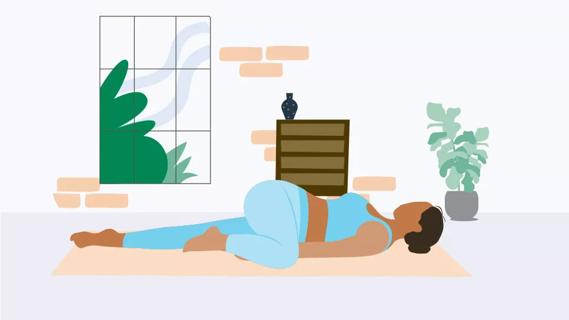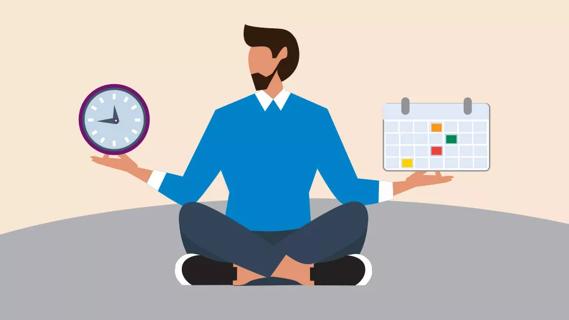This deep-breathing technique is simple but powerful

If you’ve ever felt anxious or overwhelmed, some well-intentioned person has probably given you the advice, “Just breathe.” When you’re in the midst of a stressful moment, though, that can be much easier said than done.
Advertisement
Cleveland Clinic is a non-profit academic medical center. Advertising on our site helps support our mission. We do not endorse non-Cleveland Clinic products or services. Policy
Integrative medicine specialist Melissa Young, MD, explains how to do the box breathing technique, a simple but powerful method of focusing on your breath that can help you get — and stay — calm.
Box breathing is a form of yogic deep breathing employed by the United States Navy SEALs and by stressed-out people everywhere. It’s also known as sama vritti pranayama, born of the yogic practice of pranayama, or focusing on the breath.
Its common name, “box breathing,” refers to the fact that a box has four sides, a concept represented here by breathing while you slowly count to four for a total of four times — four counts of breathing in, four counts of holding your breath, four counts of exhaling and four more counts of holding after your exhale.
This technique goes by other names, too:
“I love breathwork because it’s easy, it can be done anywhere and it has a potent effect on your physiology,” Dr. Young says. “It’s really very powerful.”
She explains what box breathing, like other forms of breathwork, does for your body.
The biggest benefit of box breathing is relaxation, especially in times of stress. Studies show that regulating your breath can lower levels of the stress hormone cortisol and maybe even help lower blood pressure.
Advertisement
In times of stress, your sympathetic nervous system is on high alert. Box breathing can help you move out of that state by tapping into the bodily system responsible for rest and digestion — the parasympathetic nervous system. The parasympathetic nervous system is the opposite of the sympathetic nervous system, otherwise known as “fight or flight.”
“When we’re anxious, we breathe shallowly and quickly, which actually creates more anxiety within your body,” Dr. Young explains. “We can use breathwork to move out of the fight-or-flight state and into that parasympathetic nervous system.”
You don’t have to be stressed to benefit from this breath exercise. Practicing box breathing is an opportunity to bring mindfulness to your breath, which is a valuable practice even in tranquil times.
“It allows you to slow your breath, and it also has an aspect of meditation,” Dr. Young says. “As you’re breathing, you’re also silently counting, which is a kind of mantra meditation that, again, calms the nervous system and brings you into the present moment.”
Don’t put too much pressure on yourself to master the box breathing method right away. “You don’t want to go too slowly or too quickly,” Dr. Young says. “Stay at your comfort level, making sure you’re breathing very gently and not straining.”
How simple is that? In fact, box breathing’s straightforwardness is what makes it so accessible — and so impactful.
“Box breathing’s simplicity is its greatest strength,” Dr. Young says. “When you start out with other forms of breathwork, you can almost get more anxious by overthinking it. But this is just very simple breathing and counting.”
She recommends practicing one or two times a day, regardless of how you’re feeling. Try it out first thing in the morning or after a stressful day of work.
At first, you may have a hard time keeping your breath steady for all those counts of four. But as with anything, you can get better at it with a little bit of practice.
“Over time, this becomes easier, and you’ll be able to extend that count to four more easily and slow your breathing down for even more benefit,” Dr. Young says.
And working on your box breathing in times of calm can help you harness it in times of anxiety, even going so far as to lessen your body’s overall response to stress.
Advertisement
“The nervous system is not fixed; it’s plastic,” Dr. Young says. “We can change it by learning how to be less responsive to stress and how to calm that response.”
To hear more on this topic, listen to the Health Essentials podcast episode “Breathwork for Beginners.” New episodes of the Health Essentials podcast publish every Wednesday.
Advertisement
Learn more about our editorial process.
Advertisement

What this natural breathing response may be telling you

Identify your triggers, set ground rules for your break and start practicing mindfulness

A diabetes diagnosis, new or long-standing, can trigger reactions like grief, stress, depression and frustration, but symptom relief and help are available

Too much screen time and unrealistic expectations and perceptions and can lead to an increased risk of anxiety and depression

This mindful practice is designed to give you mental and physical relaxation

Resolve to move a little more, drink a little less, eat a little healthier, sleep a little better and destress a lot

Being the center of attention doesn’t mean you have to exile your guest stars

Rethinking your Mondays might make the ‘Sunday scaries’ a thing of the past

Type 2 diabetes isn’t inevitable with these dietary changes

Applying a hot or cold compress can help with pain